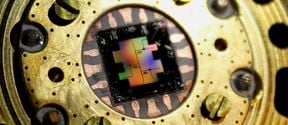Atomic Scale Physics
We focus on the experimental study of nanostructures, where the precise nature and location of every atom matters.

Researchers at Aalto University observed an exotic superconducting phase in a monolayer van der Waals material. Their paper, titled “Evidence of Nodal Superconductivity in Monolayer 1H-TaS2 with Hidden Order Fluctuations,” was featured on the back cover of the latest issues of the Advanced Materials journal on November 9, 2023.
Since its discovery in 1911, superconductivity is one of the most widely studied phenomena in experimental condensed matter physics. Among the wide variety of materials displaying this phenomena, unconventional superconductors have puzzled physicists over last few decades.
Moreover, the research in quantum materials has observed a paradigm shift since the discovery of graphene, which has ignited interest in other two-dimensional van der Waals materials. In the case of this finding, the researchers were able to converge the two subjects of two-dimensional materials and unconventional superconductivity.
Utilizing scanning tunnelling microscopes (STM) at OtaNano’s Nanomicroscopy Center, the group observed superconducting behavior consistent with a six-fold nodal pairing.
“We grew an atomically clean layer of 1H-TaS2 on graphite using a state-of-the art technique called molecular beam epitaxy,” says Research Fellow Somesh Ganguli, joint first author of the paper. “Below the temperature of 1 Kelvin, we observed superconductivity in the system, characterized by a spectral gap incompatible with a Bardeen–Cooper–Schrieffer (BCS) gap indicating the unconventional nature of the superconductivity.’’
The experiments also uncovered the presence of many-body excitations around the superconducting gap.
“These excitations might be related to hidden order fluctuations, and they can aid our fundamental understanding of pairing glue in unconventional superconductors,” says Assistant Professor Jose Lado.
This discovery adds a building block to the 2D material toolbox that can be used for realizing designer heterostructures with completely new electronic properties.
“For example, it can lead to future electronic devices with potential applications in quantum technologies,” says Professor Peter Liljeroth.
Researchers involved in the paper come from Aalto University’s Atomic Scale Physics research group, headed Liljeroth, as well as the Correlated Quantum Materials group, headed by Lado.
The experiments utilized equipment from the Nanomicroscopy Center (NMC) at OtaNano. The NMC hosts high-resolution electron microscopy, scanning probe microscopy, and X-ray scattering instruments for soft, hard, and biomaterial sample imaging and characterisation. OtaNano is Finland’s national research infrastructure, comprising Micronova, NMC, and the Low Temperature Lab.

We focus on the experimental study of nanostructures, where the precise nature and location of every atom matters.

Correlated Quantum Materials Group (CQM)

OtaNano is Finland's national research infrastructure for micro-, nano-, and quantum technologies



